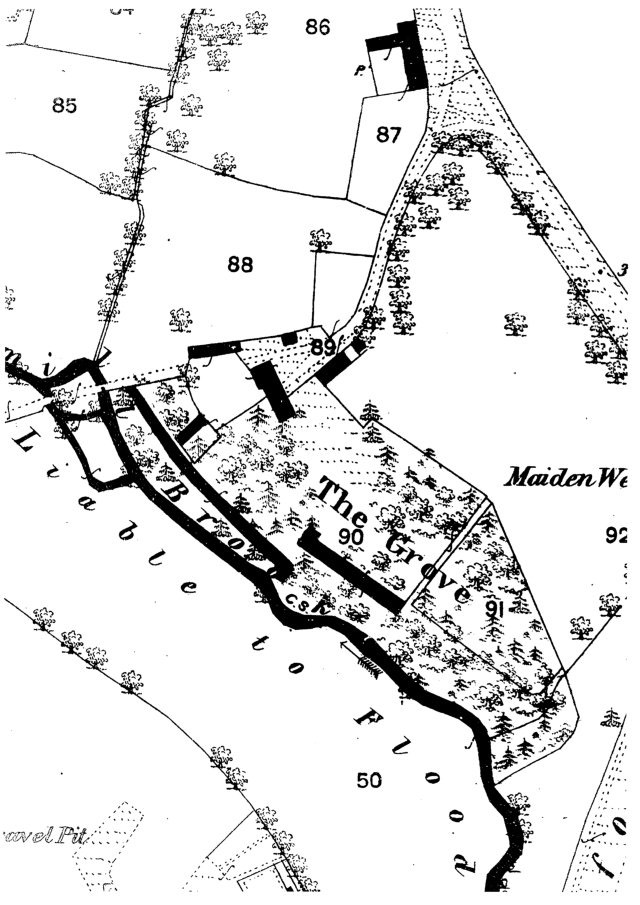If the Willington map is examined more closely, just above Watchfield House there is a ditch that lies parallel with the course of the brook. We know that it is a ditch because I remember it most clearly. The Willington map shows the ditch with breaks in it, but it was continuous. Its southern end turned towards the brook and at its northern end ran under the trackway through a brick lined tunnel into a circular depression. Although the exact purpose of the ditch is still something of an enigma we can be certain that it represents a clear case of water management. One of the main uses of flowing water was to harness power and the whole layout at Watchfield House strongly suggests a Mill.
The Hearth Taxes of 1662/3 show a property containing 8 hearths occupied by Richard Franklyn, which must have been a substantial building, and the only building to fit that description was Watchfield House. If Richard Franklyn lived in such a property in 1663 and had an association with Thomas Young, the Miller, it seems more than likely that such a mill would have been located on the estate. A conveyance dated 1786, (BRO D/EX310/16) concerning a property just to the north of Watchfield House, contains this sentence in part; ‘and the Mill Pond on the West and with the Yard and Barton belonging to the dwelling house lately of Ann Blagrave on the South.’ Other information in the document confirms that this reference to a ‘Mill Pond’ must be in the close proximity of Watchfield House. It would suggest therefore, that the circular depression on the north side of the trackway was the Mill Pond referred to. Another clue is found in the Saxon boundary description of the year 931, which describes; ‘Along the stream to the Mill Stream.’ The Ordnance Survey map of 1878 in Picture 34 below, and the clip from the Barrington Estate Map, Picture 35, clearly shows channel cuts on the Shrivenham side of the brook. The wall shown in Picture 36 marks where a channel was later blocked off. The aerial photo of 1946 (See Picture 20 in Chapter called Watchfield House) shows quite clearly two channels almost creating a small island.
About 500 yards downstream from Watchfield House is the site of what is generally known as Tuckmill. In recent years the location of Tuckmill seems to have become something of a mystery, in particular among those writers and historians of neighbouring parishes. Although there is precious little to see now, there is no mystery as to its location. It lies at Grid Ref: SU 9010 2415. (Please see Chaper called Little Mill). Included in the entry of the Domesday Survey of Watchfield it states that; ‘There are 8 slaves, and a mill rendering 25s.’ So at the end of the 11th century we know there is a mill within the parish. By the early 17th century we know there are two mills, one called West Mill and the other known as Little Mill. West Mill is located on the River Cole just off the Highworth road and still bears that name today. (See Chapter of that name) The location of Little Mill was unconfirmed and popular assumption was that it and Tuckmill were one and the same. But confirmation was needed.
Included in the Domesday Survey of Shrivenham it notes that; ‘In the manor are 2 mills rendering 20s'. Of the mills of Shrivenham we can account for one of them, Friars Mill, being modern day Friars Farm located on the Highworth Road out of Shrivenham on the B4000 at Grid Ref: SU9055 2220. But where could the second mill have been located ? A study of the water courses around Shrivenham Parish does not leave much in the way of choice. On the West we have a small section of the River Cole running north to Friars Mill. There is no obvious spot on this section that would suggest another mill. There is nothing in the way of a substantial water course on the south until we reach Beckett. Here several small courses join together and enter the ornamental grounds of Beckett House, when it leaves that estate by the old A420 and turns into Tuckmill Brook. It is at this location that some authors have suggested that a mill once stood, and also that it was the ancient mill known as Fowers Mill of the White Capon fame. However, a close examination of the site shows no evidence whatsoever of ancient water management other than the cuts put in for the nearby lakes of Beckett Estate. Also documentary evidence suggests Fower’s Mill is one and the same as today’s Friar’s Mill mentioned above, the name having been corrupted over the centuries. For a more detailed explanation please go HERE. From this geographical point onwards, the only place where a mill could have been located, is along this stretch of brook, that is to say, either Watchfield House or Tuckmill. Moreover, the physical evidence would suggest that any mill on the Watchfield House site would have been located on the Shrivenham side of the brook.
Information from the Shrivenham Hundred Court meetings (D/EEL M38) show William Fairthorne held Little Mill as early as 1616 and church records show that his son William was baptised at Watchfield in 1606. We also know by the drawings that there existed a whole farm at Watchfield that included the mill. With this information, it is now possible to make sense of the ‘The Mills.’ The two mills within the parish of Shrivenham referred to by the Domesday Book, are Friars (Fowers) Mill and the mill located at the site of the old Watchfield House (see pics 34, 35, 36). The one mill entry for Watchfield is not clear yet whether it refers to West Mill or Little Mill (Tuckmill).

Picture 34. Above. Watchfield House location - courtesy Berks Record Office, Ordnance Survey.
Ref : BRO MF 602. Sheet No 12.8
Picture 35 (below), taken from a Barrington Estate map of 1865 (Courtesy of Shrivenham Heritage Society) shows the same in more detail

Picture 36. The wall blanking off the old mill cut at Watchfield House.